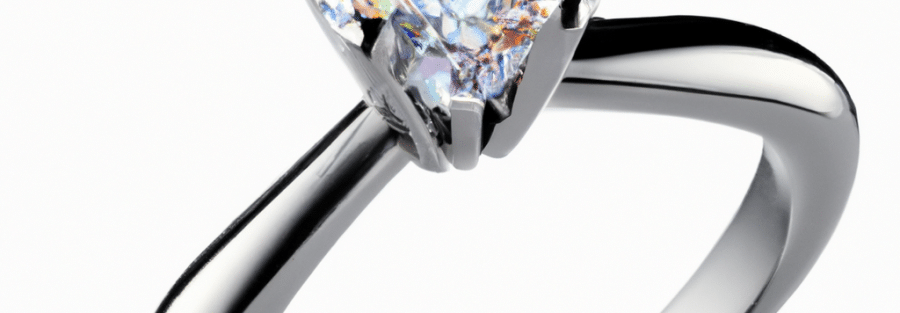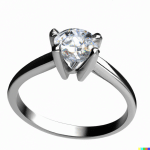Getting engaged is one of the most significant milestones in a person’s life. It’s a time of joy, excitement, and, for many, a time to start thinking about the perfect diamond engagement ring. With so many options available, it’s easy to feel overwhelmed and unsure of where to start. This guide will take you through the process step-by-step, starting with determining your budget and understanding the 4Cs of diamond quality and ending with selecting the perfect diamond shape and setting for your partner.
Determine Your Budget: Before you start shopping for a diamond engagement ring, it’s crucial to determine your budget. This will help you narrow your options and ensure you get the best value for your money. Your budget will depend on various factors, such as your income, savings, and any other expenses you may have. Remember that an engagement ring is an investment, so choosing a ring that fits your budget and your partner’s taste is essential.
Understand the 4Cs of Diamond Quality: The 4Cs of diamond quality are Carat, Cut, Clarity, and Color. Understanding these factors will help you choose a high-quality diamond within your budget.
Carat: Carat refers to the weight of the diamond. The higher the carat weight, the more expensive the diamond will be. However, higher carat weight does not always mean a more beautiful diamond. A smaller diamond with excellent cut, clarity, and color may appear more beautiful and valuable than a larger diamond with inferior qualities.
Cut: Cut refers to the diamond’s proportions, symmetry, and polish. A well-cut diamond will reflect light beautifully, making it appear more brilliant and sparkly. The cut of the diamond is the most critical factor in its beauty, so it’s essential to choose a diamond with an excellent cut grade.
Clarity: Clarity refers to the number of imperfections, or inclusions, within the diamond. A diamond with fewer inclusions will be more valuable and appear more brilliant. However, remember that diamonds are naturally formed, and it’s rare to find a diamond without any inclusions. The goal is to find a diamond with inclusions that are invisible to the naked eye.
Color: Diamonds are graded on a scale from D to Z, with D being the most colorless and valuable. However, a diamond with a slightly lower color grade may still appear white to the naked eye and be more affordable. The choice of color grade depends on personal preference and budget.
Choose a Diamond Shape: The shape of the diamond will play a significant role in the overall look of the ring. Some popular diamond shapes include round, princess, cushion, oval, emerald, asscher, pear, and marquise. The choice of diamond shape will depend on your partner’s style and preference. Remember that each diamond shape has unique characteristics, and choosing a shape that complements your partner’s finger and hand is essential.
Select the Setting: The setting refers to how the diamond is placed in the ring. Several types of settings include solitaire, pave, bezel, halo, and three-stone. The choice of setting will depend on personal preference and the style of the diamond. For example, a halo setting will enhance the brilliance of a round or cushion-cut diamond, while a bezel setting will provide extra protection.
Frequently Asked Questions (FAQs):
What is the best diamond shape for an engagement ring? The best diamond shape is subjective and depends on your partner’s style and preferences. Some popular choices include round, princess, and cushion cuts. Round diamonds are classic and timeless, while princess-cut diamonds are modern and elegant. Cushion-cut diamonds have a vintage feel and are perfect for those who love a romantic and whimsical look.
What is the most important C in diamond quality? The most important C in diamond quality is cut. A well-cut diamond will reflect light beautifully, making it appear more brilliant and sparkly. The diamond’s symmetry, proportions, and polish determine the cut grade. Choosing a diamond with an excellent cut grade is essential to ensure maximum sparkle and brilliance.
Should I prioritize carat weight over diamond quality? No, carat weight is not the most critical factor in diamond quality. A smaller diamond with excellent cut, clarity, and color may appear more beautiful and valuable than a larger diamond with inferior qualities. It’s essential to prioritize the overall quality of the diamond over its size.
Google’s People Also Ask (PAA): What is the cheapest diamond shape? The price of a diamond will depend on several factors, including the carat weight, cut grade, clarity grade, and color grade. However, generally speaking, round diamonds tend to be less expensive than other diamond shapes. Round diamonds are more popular and easier to cut, producing less wasted diamond rough. Additionally, some diamond shapes, such as pear and marquise, require more diamond rough to create, resulting in a higher price. However, keep in mind that the price of a diamond will depend on several factors, and choosing a diamond with excellent quality and within your budget is essential.
Choosing the perfect diamond engagement ring is a significant decision, and it’s essential to take the time to make an informed choice. Start by determining your budget and understanding the 4Cs of diamond quality. Then, choose a diamond shape and setting that complements your partner’s style and preference. Remember that the most critical factor in diamond quality is the cut grade, so choosing a diamond with an excellent cut is essential. With this guide, you can confidently select the perfect diamond engagement ring for your partner and create a memory that will last a lifetime.



